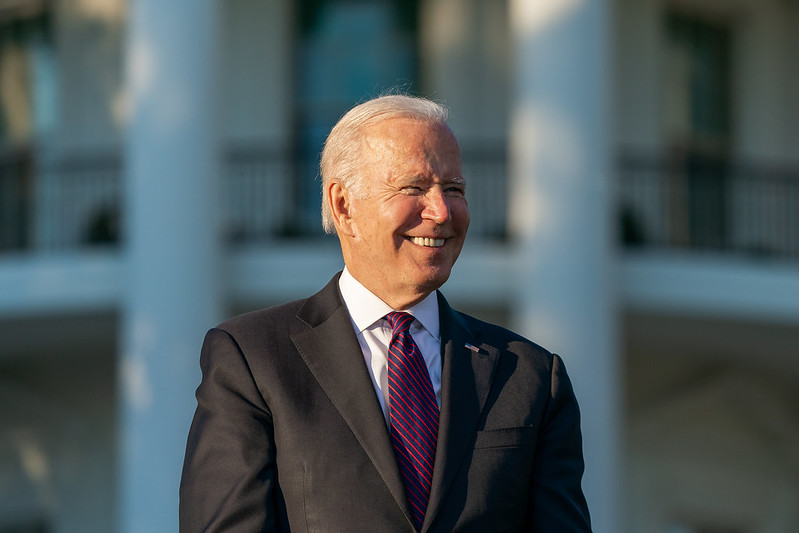
Talks between the world’s two superpowers were cordial. What comes next?
On Monday evening, coming off the signing of the historic infrastructure investment bill, President Biden sat down for a three-hour virtual meeting with Chinese leader Xi Jinping.
The call came at a moment of increased tension in U.S.-China relations. On the trade front, China continues to push limits by utilizing illegal subsidies, currency manipulation, and other unfair trade practices to dominate global industries. China also has failed to honor its trade obligations, including the “Phase One” trade deal with the U.S. that was announced during the Trump administration.
There’s also issues of international security, including the future of Taiwan, the oppression of Tibet, China’s nuclear arsenal, and the need to reduce emissions to tackle climate change.
And perhaps most urgently, China’s government continues to violate international human rights norms by perpetrating a genocide in Xinjiang against the Uyghur people and other ethnic minorities.
They had a lot to discuss, as AAM President Scott Paul noted on Twitter.
Anyway, Biden and Xi had a call to talk about all of these issues and more. Noting concrete came out of their chat, and neither side was able to announce any major policy wins. But both nations seemed pleased with how it went, with U.S. officials describing it as a “respectful and straightforward” conversation that centered on pressing needs like the ongoing COVID-19 pandemic.
It’s actually what happened after the call – and the policy items on the agenda in Washington – that are perhaps more indicative of where things stand.
On Tuesday morning, Washington Post columnist Josh Rogin reported that the Biden administration is preparing to announce a diplomatic boycott of the upcoming Winter Olympic Games in Beijing over China’s human rights abuses, including the abhorrent treatment of the Uyghurs. It’s a move that China’s government will likely be angry about, but it’s also move that has bipartisan support in Washington. Speaker Nancy Pelosi (D-Calif.) and Sen. Mitt Romney (R-Utah) are among those who have backed the idea, as it would allow the U.S. to show its displeasure with the Chinese regime’s actions while also allowing U.S. athletes to compete.
Meanwhile, the Biden administration is selling the passage and implementation of the infrastructure package as an important step in countering China. While visiting New Hampshire on Tuesday, Biden made a point to note that “next year will be the first year in 20 years that American infrastructure investment will grow faster than China’s.”
But while the infrastructure bill is a solid start – the Alliance for American Manufacturing strongly supported the legislation – it is only a start. There’s a whole lot of work to do if the U.S. is serious about winning “the competition for the 21st century,” as Biden himself put it on Monday.
For one, China’s unfair trade practices remain unchecked, almost laughingly so. That’s allowed China’s regime to continue its quest to dominate global industries, which is not only an economic issue, but also a matter of international security.
It’s not just the U.S. impacted, either. On Tuesday, for example, news broke that a Chinese state-owned company bought an Italian drone maker without the Italian government realizing, allowing China to capture a whole lot of intelligence.
In response to all this, the Biden administration has focused on uniting U.S. allies to take on China when it comes to trade. That’s good, because it’s clear that when it comes to these issues, the status quo isn’t working – significant, coordinated international pressure must be put on China’s government to cease its unfair trade practices, and the U.S. shouldn’t be afraid to take action of its own when appropriate.
And there’s a whole lot more the U.S. can do on its own to counter China, too.
For one, it’s paramount that lawmakers finally advance the U.S. Innovation and Competition Act – a.k.a. the “China Competitiveness Bill” — which passed the Senate with resounding bipartisan support earlier this summer.
USICA, as the bill has also been called, is a $250 billion investment in advanced manufacturing and technology that is designed to help U.S. industry catch up to China. Notably, it includes $52 billion to grow U.S. semiconductor manufacturing, invests in new advanced research institutes, targets Chinese infiltration of American intellectual property, and dramatically expands the scope of research, development, and deployment programs throughout the government.
We’re at a pivotal moment, in which the U.S. can invest in itself to take on China – including by reviving its manufacturing base and leading the industries of the future – or watching China assume global leadership (and saying goodbye to a whole bunch of jobs in the process).
The U.S. must get serious about leading the way when it comes to things like electric cars, semiconductors, and batteries, launching a manufacturing renaissance that not only preserves and grows U.S. manufacturing jobs, but also ensures that these goods are made to the highest environmental and labor standards. What good are electric cars on American roads if the plants that make them are powered by Chinese coal?
Now is not the time to be timid. Even with the $1.2 trillion investment signed into law Monday by the president, the U.S. is behind. China’s government regularly spends trillions of dollars a year on infrastructure.
That’s why we need bills like USICA. We need our political leaders to unite the world to press China on trade. We need to stand our ground on China’s abuses to the environment and human rights. We need to be thoughtful and purposeful in our response to China — and we need to get to work.
